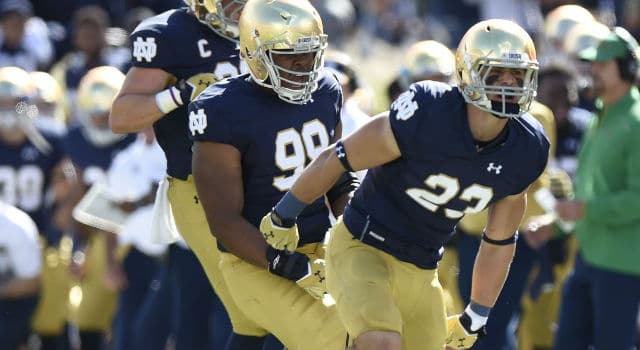

COLLEGE FOOTBALL’S BRUTAL ORIGINS
When Rutgers “lit up” Princeton 6-4 in 1869 in the first football game ever played, the game’s early defensive DNA was established. It was brutality at the line of scrimmage and ruthless, often sadistic tackling. The game’s early thuggishness prompted President Teddy Roosevelt, the Roughrider himself, in 1905, to threaten the presidents of Yale, Harvard, and Princeton, “Da Three U’s” of their era, with abolishing football.
THE FORWARD PASS APPEARS
Notre Dame stepped in in 1913, on All Saint’s Day no less, and Gus Dorais completed 14 of 17 passes, many of them to Split Norway’s own Knute Rockne, to rout Army and introduce the “forward pass,” effectively, to college football.
But the run still ruled. The single wing, with its spinners, buck laterals, blocking quarterbacks and wingback reverses reigned supreme until Knute Rockne, inspired by the precision and footwork of Radio City’s Rockettes, introduced the box formation as a way to keep ahead of the defenses.
T FORMATION CHALLENGES THE SINGLE WING
In the mid-30’s Clark Shaugnessy introduced an upgraded version of the T formation to George Halas and the Bears and Halas went all in. It even impacted a fight song, as
“Bear Down Chicago Bears” includes a paean to Shaugnessy:
“We’ll never forget the way you thrilled the nation
With your T formation”
The T led to the Split T, the Wing T, and that irascible rascal the Double Wing, all constant efforts to stay ahead of the defenses. In South Bend, Frank Leahy, over the howls of Rockneites, Knights Templar and Tories, scrapped Rockne’s box formation and transformed to the T formation. The howlers shut up. Leahy won a bit at Notre Dame.
The die was cast and the single wing faded into oblivion in the late 50’s in D-1 football.
But it was still about running the football. When Ara’s student Schembechler and Woody Hayes played their initial editions of the 10 year war, each tried to bludgeon the other with the off tackle play. Guile and space had little to do with it. Bighorn Sheep brought more subtlety to their skirmishes than Bo or Woody. The game was fought between the tackles. The results bore witness to the witless offenses. The first six games in that stubborn series were
- UM 24 OSU 12
- OSU 20 UM 9
- UM 10 OSU 7
- OSU 14 UM 11
- UM 10 OSU 10
- OSU 14 UM 12
That’s right, the teams TOGETHER averaged less than a touchdown per quarter.
SID GILLMAN, VERTICAL PASSING, THE BONE AND THE VEER
Sid Gillman, who was Ara Parseghian’s coach at Miami, began perfecting the Vertical Passing game, and sowing the seeds of the West Coast Offense while coaching the LA Rams of the NFL and the LA/San Diego Chargers of the AFL. Gillman’s schemes and aerial dreams influenced West coast Pac 8, then Pac 10 Football, but it stayed local at the college level.
Passing was subject to great experimentation at Stanford where players like Frankie Albert, John Brodie, Jim Plunkett and others were lighting it up, and with the 1966 Heisman trophy winner, Steve Spurrier, who after a quarter century of incubation would introduce a terrifying, dominant passing attack at his alma mater, the University of Florida.
But a star had appeared in the Southwest, and Emory Bellard brought the wishbone to Austin. The wishbone was quickly coopted and perfected in Norman. The shift was from power to speed, from between the tackles to around the end, from brute force to guile and timing. And in that offense, and its stepchild the veer, the seeds of modern spread football were sown. The search was for players like Jack Mildren, Thomas Lott, Slick Street, Jamelle Hollieway, even Turner Gill, option magicians who didn’t need to throw the ball.
John Jenkins at Houston produced a blip on the screen with his run and shoot, but passing and running offenses were still miles apart.
Ara Raoul Parseghian preferred a little of both, as did his successor at Notre Dame, Dan Devine. There is a reason their balance sent Bear Bryant to the grave with an 0-4 record against the Irish.
ARA MOVES FROM THE 4-4-3 TO THE 4-3-4
Ara allowed Johnny Ray to implement a suffocating 4-4-3 which led the Irish to the ’66 championship while allowing only 3 offensive touchdowns all year.
But Ara had to deal, after ’66, with John McKay’s fearsome USC teams and their sophisticated, Gillman-influenced passing attacks, as well as those from West Lafayette and Bob DeMoss.
So Ara retooled his defense from a 4-4-3 to a 4-3-4, which was in place for the 1973 championship Ara won. What was more significant was that the “3” in ’66 were Smithberger, O’Leary and Schoen, and the “4” in ’73 were Bradley, Rudnick, Townsend and Barnett.
DESEGRATION AND ATHLETICISM
Brown versus Board of Education was decided in ’54 but it was LBJ’s Civil Rights Act in 1964 that lent both teeth and federal power and dollars to ending segregation in America. Separate but equal was a lie which had been buried.
The southern conferences, the ACC, SEC and SWC began to integrate, schools began to integrate and black athletes began receiving the same equipment, nutrition and coaching which Caucasian athletes had enjoyed.
The ’69 Texas Longhorns were the last all-Caucasian roster which won a national championship.
A SWIRL OF INFLUENCES
The wishbone and veer had moved running from power to speed, timing and space.
All American kids, even fast ones, could now compete.
Passing leagues and 7 on 7’s were coming into vogue.
Nike and Adidas were honing skills with summer camps and skill coaching, allowing football players to close the skill and coaching gap which Howard Garfinkel and Tom Konchalski had brought to basketball.
RUN, PASS or BOTH?
A wishbone or veer quarterback had to be highly skilled and proficient in the nuances of the option. A pro style passing attack required the ability to read defenses, stay in the pocket and throw into tight windows. There were specialists in one or the other, but not both.
GOODBYE FULLBACK
With the end of the iso play, and the use of multiple wide receivers and dual and triple TE sets, the fullback went the way of the Bison.
SPREAD OFFENSES
It took a while to develop but the modern spread provided opportunities to be explosive in both the running and passing game, if you could find the right quarterback. But the spread quarterback was throwing into vastly wider windows, often on the run. If the quarterback had some modicum of running ability and further had the ability to either throw on the run or scramble, reset and throw, the offense had a tremendous advantage over the defense. The quarterback needed some passing ability but did not need to be Aaron Rodgers or Phillip Rivers!
Spread quarterbacks were more abundant than “pure” pro style passers.
Urban Meyer, in an offense he jointly designed with Mike Sanford while they were both assistants at Notre Dame, made a firm commitment to the spread with a dual threat quarterback. It started with Alex Smith, who helped take Meyer and Utah’s Utes to a BCS bowl victory, and continued with Tim Tebow at Florida. But it was another Meyer recruit who was the prototype for the modern spread quarterback. Vince Young of Texas was another of the spread pioneers, a magnificent college player inadequate for the pros. But a kid from Atlanta, who had trouble in Gainesville, wound up at Blinn JC and became a one year wonder at Auburn.
Cam Newtown was the prototype, the archetype, and easily took Auburn to the national title. He was quickly followed by Johnny Manziel, Pat White, Denard Robinson, Nick Marshall, Marcus Mariota, Robert Griffin,
Everett Golson, Dak Prescott, Trevonne Boykin, Jameis Winston and a trio of spread qb’s at OSU, Braxton Miller, Cordale Jones and JT Barrett. America’s best returning quarterback is Deshaun Watson of Clemson, who helped hang 40 on Kirby Smart’s last defense at Alabama.
In the last two final fours. There were only two “non-runners” Connor Cook of MSU and Jacob Coker of Alabama. Winston, Mariotta, Jones, Sims, Baker Mayfield and Deshaun Watson all had some wheels as well as the ability to pass.
HIGH SCORING IS HERE, FOR NOW.
These are the determining games for the last three years
- FSU 34 Auburn 31
- Oregon 59 FSU 20
- OSU 42 Bama 35
- OSU 42 Oregon 20
- Bama 38 Michigan State 0
- Clemson 37 Oklahoma 17
- Bama 45 Clemson 40
Every game, even the embarrassing shutout of over-their-head Michigan State against Alabma, 38-0, the lowest scoring of the games listed above, was higher scoring than the highest scoring of any of the games in the ten year war between Bo and Woody. Bo and Woody? Recquiescat in pace. Long live the spread!
THREE WIDE IS THE NEW NORMAL
AND FOUR AND FIVE WIDE IS NOT THAT ABERRANT
Asking safeties to be outstanding in run support against the speed in space the spread provides, to contain the quarterback, AND cover receivers one-on-one is a bridge or two too far. You need quicker players, quicker than linebackers or “traditional” safeties to cover slot receivers and chase down quarterbacks. You need a Honey Badger, a S’ua Cravens or a Shawn Crawford.
Thus the “slot cornerback.” At Notre Dame, with a healthy Shawn Crawford, it is NEARLY a starting position. A linebacker must yield to Crawford. Ergo, 4-2-5.
NUMBERS DON’T LIE
ON THE 2016 Notre Dame roster, when the frosh arrive, there will be 16 defensive backs, 8 linebackers. What does that data suggest?
In the NFL last year, roughly 30% of the defensive sets had 4 DBS, 50% had 5 DBS and 20% had 6 DBS. This allocation is seeping, slowly but noticeably, to college football. At Notre Dame this Spring, the dime package had Redfield and Studstill at Safety, Crawford still manning the slot and Drue Tranquill as sort of a Minotaur, half man, half bull, part safety, part linebacker, part blitzer, part Brian Van Gorder’s weapon of mass destruction.
Ara changed from the 4-4-3 to the 4-3-4 because it was the right thing to do. This morphing into a 4-2-5 is organic, dynamic, correct, natural, more gradual than precipitous.
Remember Brian Kelly’s DNA is as an outstanding linebacker, albeit at Assumption. He more than anyone else knows when it’s time for linebackers to decrease so that defensive backs and defensive performance, may increase.
The 4-2-5? It is an idea whose time has come.
Go Irish!!
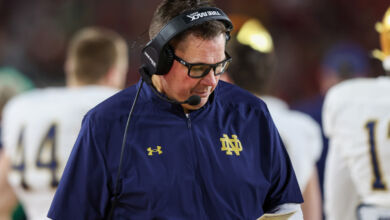
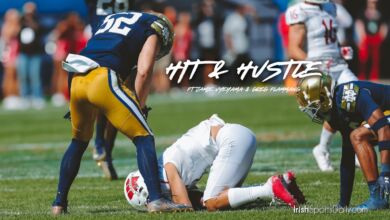
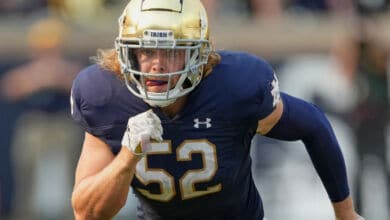
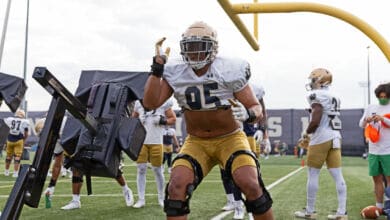
If only BVG would take Bruce Johnson’s advice and use the 2-1-4-3-1 like Ara did.
The defense probably wouldn’t give up a single point all year.
Would certainly make “690 points in three season’s” sound a whole lot better!
You have to love Duranko but you can’t articulate any ideology that will justify giving up 690 points in two seasons.
Beatha, thanks, I had posted another comment yesterday, but it is “awaiting moderation” It is an attempt to contextualize the hire, the rainson d’etre of the hire, and the retooling that has been completed already by BVG and his no longer Hawkeye based staff. Just remember when you see it, that it was composed before you posted your comment.
when watching the Irish, I doff the blue and gold classes (it’s easy when you’re bipolar) and see what I see, the iinternetocracy be damned.
I think your analysis of the current defensive “assets” is co4rect. Last year, out of christianm empathy I stopped listing the yards yielded by the misplays, missed tackles and non-athleticism of the departed at MLB. too painful, too gratuitous.
I am compelled to agree with your last paragraph. But I am “ALL IN” on the “Magnificent Seven” that Lyght recruited. Sure, it will take a year. Just note this, beatha. Jalen Elliott’s “idol” is the late, great, Sean Taylor, the best college safety these eyes have ever seen. rankings are subjective, but for me, in COLLEGE, it was (1) Sean Taylor (2( Jack Tatum (3) Ronnie Lott. But just ask yourself, when on that grassy campus in Northern Indiana, has an Irish FROSH SAFETY ever come in with a more elegant role model than Sean Taylor?
Great and desperately needed article Duranko. Good to have you back.
As I’ve insinuated, as politely as I’m capable, that those calling for BVG’s head have little to zero understanding of defensive theory, much less what he’s actually trying to accomplish, and the weaknesses he’s had to work with. Watching through the last seasons games, it’s glaringly obvious that the DB play is the primary culprit. Luke is strong in coverage, but stomach turning as a tackler, diving for shoelaces all season. Russell is hit and miss in every aspect of the game. Shumate tackles well in space, but struggles to cover 260lb TE’s. And Redfield, is a sewage fire, always out of position, hitting every wrapped up ball carrier with his helmet, but incapable of a single one on one tackle. Add all this to an agonizingly slow MLB that traps the most talented player on the field in coverage/spy, and you have a recipe for passing at will in the middle.
What’s most interesting is that the pressure on QB’s was actually really good throughout the season, despite the current meme understanding. But, if you can’t cover receivers directly in front of a panicked QB, pressure becomes a moot endeavor.
While I’d agree that the defense may actually improve this season, sadly, I think we’re a year away from a lights out nickel base.
A FEW THINGS ABOUT THE IRISH DEFENSE.
When Kelly’s 2012 team got thumped by Bama, Kelly realized that his veteran defense was more inadequate for the task than the young, redshirt-freshman led offense.
Kelly realized, as he said a year later after Diaco departed, that Notre Dame needed an aggressive attacking style defense to compete at the top level in championships.
RETOOLING is HARD. And TIME CONSUMING. Everyone wants immediate change, but first there is a slowdown, disorientation, withdrawal from the old before rising to the new level.
Van Gordder inherited
A 3-4 passive scheme
Zone principles in the secondary
Iowa mafia-Diaco, Cooks, Elliott
Players recruited for a 3-4, read and react.
As a welcoming gift, Van Gorder was given the Frozen Five, which discriminated against the defense: Ishaq Williams, KeiVarae Russell, Eilar Hardy and Kendall Moore. Then injuries which wiped out the middle of the defense: Jones Day, Schmit, Tranquill/
THIRD YEAR-it applies not only to Notre Dame coaches but to their defenses.
Brian now has HIS coaching staff in place.
He has a majority of players who were recruited to play a 3-4, with attacking principles with man press coverage.
For NOW, he has no Frozen Four.
Van Gorder’s defense, with its nuances, is the kind of defense ND will need in a Final Four game. We will, but for the occasional Michigan State which undeservedly slips through, be playing an outstanding offense, as outlined above. Just check the points yielded by Kirby Smart’s defense in the last thre season-ending games for Alabama.
It’s a brave new world, and Notre Dame’s best chance to win is not to replicate ’46, ’66 or ’77 but to have an outstanding, diverse, explosive offense, solid kicking game (right now we have the best pair of kickers in college football.) and an aggressive opportunistic, disruptive defense that can generate one or two or three stopped drives in a game. That is 2016 college football.
And Brian Van Gorder is the best feasible solution for that. One of the joys of the next several years is to watch Todd Lyght’s brood of 7 incoming DB frosh and how they develop on the back end.
The best of Van Gorder is yet to come, but it is arriving soon. At last, Van Gorder has had three springs to teach his game to what are now his style of players coached by people he hand picked. The retooling is complete. It’s production time.
To the BVG bashers, you speak as though you know what you are talking about but give zero reason for your opinion other than it’s to complicated for the players. You also say it hasn’t worked. Actually it has worked wonderfully each year until massive amounts of injuries. I personally don’t like the style because of the athleticism required, not the understanding. We can’t enroll the kids he could when he was coaching down south. They have to be more than athletes at ND. By the way, I live down south and see players every day that would be awesome for the team, they just couldn’t get in.
It won’t make any difference what style BVG runs. He is not the guy and Kelly needs to understand that defense does in fact win championships. ND needs a five star defensive coordinator.
A healthy, productive, multi-faceted, D Tranquill is a key, among others, to ND defense this fall.
Nice article
I hope so. The BVG defense just hasnt worked as noone can follow it.
Ara used the 2-1-4-3-1 exceptionally well and never gave up a point.
– Bruce Johnson
Prediction: (for those that care) The Irish D will be a strength this year and dominate in many of their games. By mid-season, comments regarding BVG will be about concern for him leaving for another job after the season vs. Kelly needing to fire him. This optimistic/realistic vision is based upon an expectation that injuries are at a much more reduced level this year. Weakest link may be the D-line but the overall talent, depth and experience is now there. It’s going to all come together this season! Go Irish!!!
Bottom line: “Fans” like BJ will now need to find another facet of this team to rant about.
p.s. Duranko, it sure is great to be reading your insightful thoughts again! Keep ’em coming.
p.s. To the moderators: previous comment left completely “tongue in cheek”!
Duranko is phenomenal IMO! Just threw that out there in lieu of my initial reaction to overly react in a positive way (which would’ve been awkward). Anxious to see the comments! Aren’t you? 🙂
Who is this Duranko guy? Does he know anything at all about Notre Dame football or football in general?
Haven’t seen many articles from him in the past? Get a clue!